Sexual selection, from sexy dancing to cheating, anything goes!
Introduction
Watching a wildlife documentary or simply taking a walk in the woods, you’re bound to have come across an animal with extravagant characteristics. So extravagant, in fact, that you might well wonder whether it doesn’t go against natural selection. Take, for example, a peacock’s bulky tail, the enormous fins of a fighting fish or a deer’s impressive antlers. They’re beautiful ornaments, yes, but they’re also very awkward to move around on and highly visible to predators! The question then arises: how can such features be selected when they seem to have a negative impact on the survival of the individuals that wear them?
The answer lies in a concept that I’m about to introduce to you: sexual selection. In the rest of this article, we’ll look at why, in the vast majority of species, females choose males and how they choose them.
We will then look at other non-human animals to understand some of the strategies that have been selected over the course of evolution to persuade females to mate. We’ll see that there are cheats in the animal world and that sometimes strength and beauty are no match for some clever little buggers!
Sexual selection, a story about sex
What we remember from the concept of natural selection developed by Darwin and Wallace (more details in our article on this subject) is that individuals with the most adaptive characteristics survive better, reproduce better and are therefore selected from generation to generation. However, if you’re an observer of nature, you should be able to spot an inconsistency in all these stories… In fact, if you look closely at the animal world, you’ll see that males and females sometimes have different phenotypes. Males are often more colourful or have flashy ornaments. Females generally have more discreet attributes. In terms of the theory of natural selection, it seems counter-intuitive that individuals should be selected when they are sporting multicoloured coats that make them more visible to predators and make them look very cluttered.
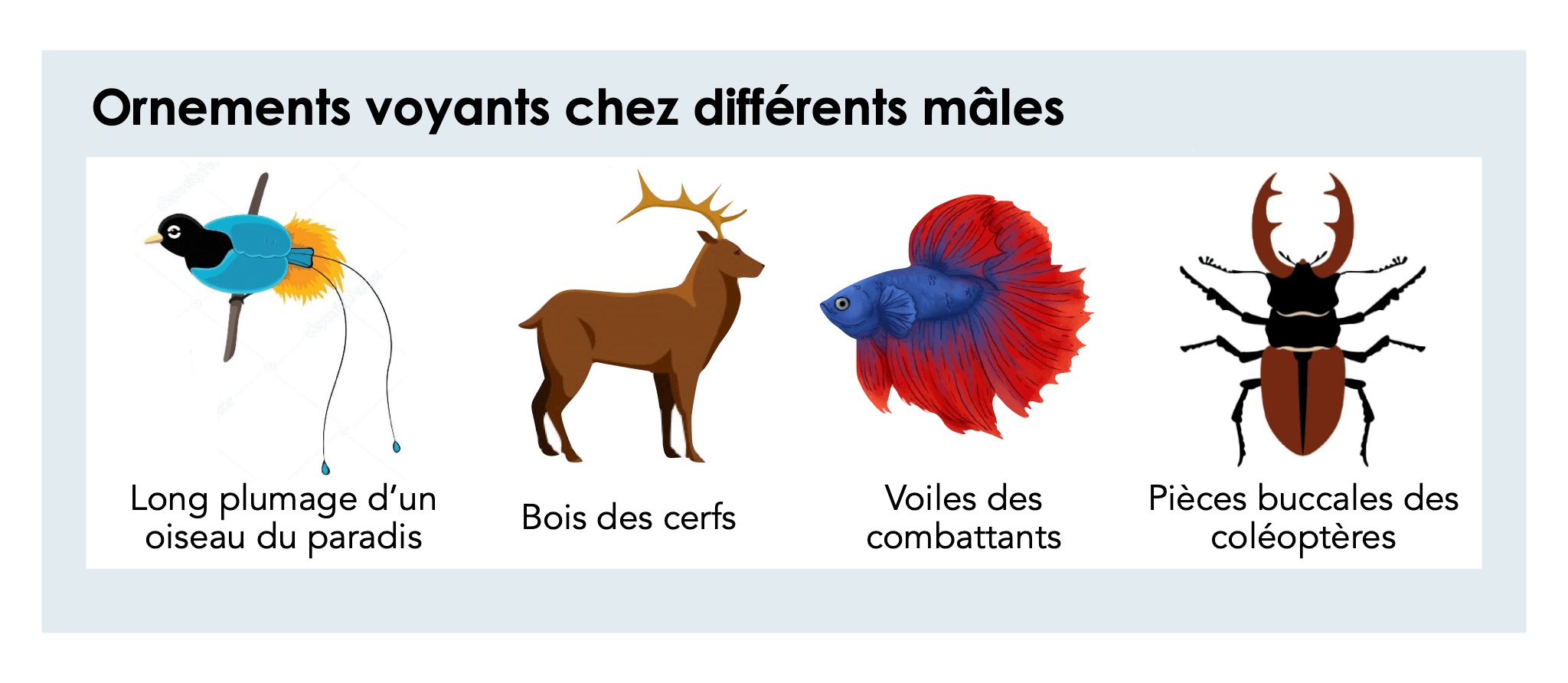
But were Darwin and Wallace wrong? What’s the point of favouring such disabling characteristics that increase the probability of dying? Well, the answer can be summed up in one simple phrase: to gain access to reproduction!
Both knew that natural selection could not be expected to favour the evolution of disadvantageous traits. Although they had differing ideas on the subject, they were nevertheless able to offer a solution to this problem: sexual selection. In his book ‘The descent of man and selection in relation to sex’[1] published in 1874, Darwin proposed a new evolutionary process different from natural selection. This process does not depend on a struggle for existence in relation to other organisms or environmental conditions, but on a struggle between individuals of one sex for possession of the other sex.
Definition of sexual selection :
Sexual selection is a theory according to which the evolution of certain remarkable physical traits such as pronounced colouring, increased size or striking ornamentation in animals can make it easier for those who possess them to obtain mates.
An explanation for the war of the sexes: anisogamy
But why is it that, in the majority of cases, it’s the males who end up with the extra ornaments!
The most widespread theory to explain this phenomenon is anisogamy. ‘Anisos’ means non-equal and ‘gamos’ means marriage. Anisogamy therefore refers to a form of fertilisation in which the gametes of the two sexes differ, particularly in size.
The male gametes (spermatozoa) are much smaller than the female gametes (oocytes). In humans, an oocyte measures around 120µm whereas a spermatozoon measures around 50µm. In addition, there is a significant difference in production cost between a male gamete and a female gamete. Oocytes live longer and contain nutritional resources, but are more ‘expensive’ (metabolically) to produce.
The main idea behind this theory is that males produce more and cheaper gametes. Females have only a limited and precious supply. This imbalance will lead to sexual conflict. Females have an interest in carefully choosing a male, while males have an interest in fertilising as many females as possible.
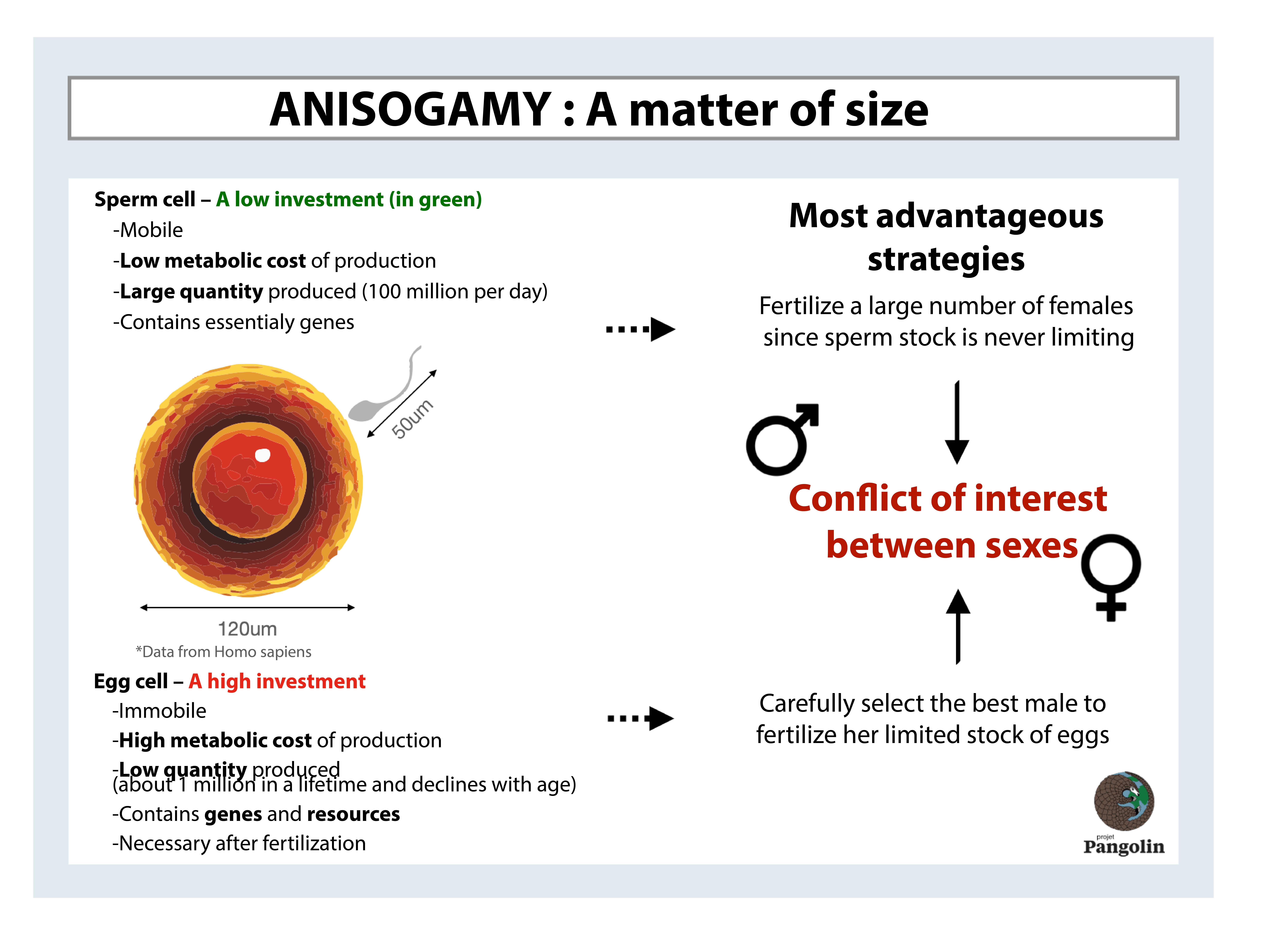
Over the course of evolution, this war of the sexes has put males in competition with each other for access to a limited quantity of female gametes, and thus to the much-hoped-for paternity.
NB : it is interesting to ask how anisogamy emerged. But also why there are differentiated sexes. One of the answers lies in the fact that it prevents self-fertilisation. If you’re interested, read this article on the subject.
The Cornelian choice of females, between direct and indirect benefits
The males’ objectives are clear. They need females to ensure that they have offspring, and they are competing to get them. What do the females gain and why choose one criterion over another?
In some cases it’s quite clear. If we take the example of a female gorilla given the choice between a pudgy gorilla with low social status or a dominant, muscular gorilla, it’s easy to see why she would choose the dominant gorilla. The male probably has access to more food and can protect his territory. The female gains physical security and food. Now, if we take the example of the peacock, it’s a little less intuitive to understand why females prefer the males who do the best cartwheels.
The choice of females is based on two main categories of criteria: direct and indirect advantages.
Sexual selection - Direct advantages
A direct advantage will be immediately identifiable by the female and will instantly increase her fertility or lifespan. For example, females can obtain: better access to food, protection from harassing males or help in raising their offspring, or avoid being infected by parasites (or other diseases) by choosing healthy males.
Direct benefits can be of various kinds. Some species offer nuptial gifts, which are usually food. This behaviour is found in a wide variety of organisms such as birds, insects and spiders. Sometimes there is a positive correlation between the size of the gift and the copulation time allowed by the female. For example, if the male provides the female with a large prey item, he will be able to transfer more spermatozoa [3,4]. In other species, such as the Red-backed Black Widow, males offer themselves as a nuptial gift by allowing themselves to be eaten [5].
Another direct and seemingly obvious advantage is choosing a sexual partner who will help raise the young for some species. Females will choose a good father to help them build a nest and feed the young. These behaviours are observed in many bird species, but also in mice.
A final example can be found in bullfrogs. Females will prefer males with the ‘best’ territory. The eggs will thus be protected from predators during their development. Sexual selection - Indirect advantages

Sexual selection - Indirect advantages
An indirect advantage is less obvious to the female and can be interpreted as a gamble. The female will have to detect whether a male is a good partner on the basis of clues that are more or less clear (to our human eyes). If she wins her bet, the female will produce healthy offspring who will in turn be able to produce numerous offspring, indirectly increasing the female’s reproductive success.
To make her choice, the female will rely on specific signals that will be interpreted as quality indicators. These are often exaggerated physical traits that have been selected in males over the course of evolution. These are called secondary sexual characteristics. There are two complementary theories to explain the appearance of these strange characteristics.
When males get carried away…
Fisher’s ‘runaway’ theory proposes that, over the generations, a non-adaptive trait that is visible and guarantees good quality will be selected by the females. A positive feedback loop then follows. Females are increasingly interested in this characteristic, so sexual selection will encourage it to increase.
For example, females will choose the males with the longest plumage because their offspring will also inherit long plumage and will in turn be chosen by the females of the next generation, maximising the probability of gene dispersal (Fisher 1930).

This mechanism will then lead to unbridled selection for the exaggeration of ornament and preference. This mechanism will continue until the production costs of the ornament exceed the reproductive benefit of possessing it. In theory it could be any non-adaptive trait as long as females can easily compare them. The cost only appears at the final stage of an evolutionary spiral.
The theory of handicap and good genes
The alternative theory to Fisherian runaway evolution is called the handicap theory. It is also known as the good genes theory.
According to this handicap theory, males with extravagant traits that are even dangerous for their survival would be males of good overall quality. Indeed, males disabled by an extravagant trait were able to survive in a hostile environment even though (for example) they had to drag around a huge multicoloured tail (Zahavi 1975). Their extravagant character would therefore be an honest signal about their physical condition and therefore their “good genes”.

All these mechanisms are based on the supposed existence of genes conferring greater vigour (“good genes” hypothesis), revealed by external handicaps and therefore only able to be developed by individuals of very high individual quality. However, evidence that females select for good genes remains scarce despite decades of studies on mate choice in many organisms. This apparent lack of consensus continues to create debate about the importance of the good gene model in the field of evolutionary biology.
What strategies do males use?
Pre-copulatory behaviour
Most of the time, when we think of sexual selection, we think of confrontations as the mating season approaches or sumptuous courtship displays. In the animal kingdom, these strategies are widespread and occur before copulation. If these behaviours have been selected over the course of evolution, it’s mainly because they allow the best males to be chosen. Both in terms of indirect advantage (if I choose the male who wins, then my offspring will probably also inherit the genes that will enable them to win the competition in turn), or direct advantage (if I choose the strongest male, then I increase my probability of survival and that of my offspring because I will be better protected from predators).
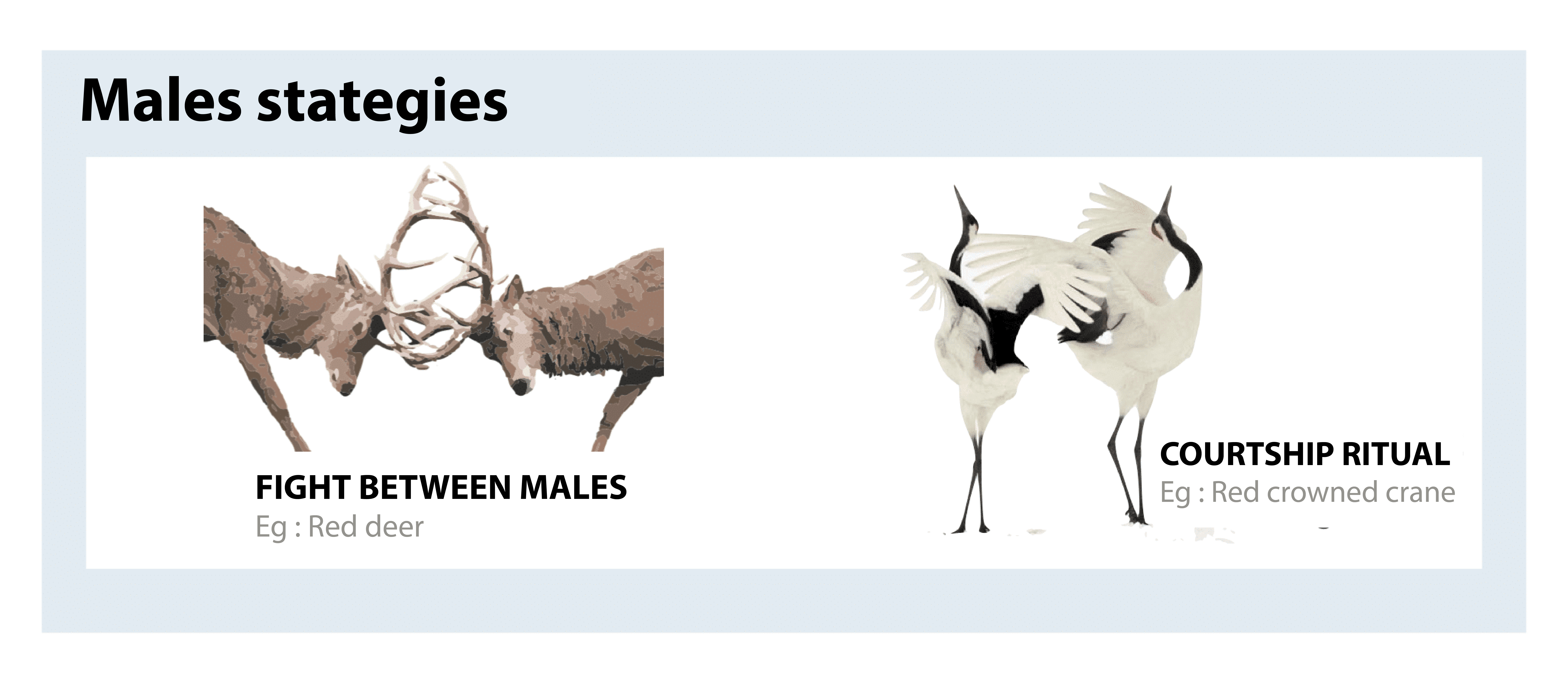
Sperm competition, sexual selection in detail
Females sometimes choose not to put all their eggs in one basket. In these species, they often mate with different males to maximise their chances of having healthy offspring. In this situation, the competition between males takes place at sperm level and is called sperm competition.
Males have no interest in other males impregnating the female with whom they have just mated. Thus, in the course of evolution, multiple strategies have emerged at different times during the copulatory stage.
Before copulation, the hunter loses his place
In some species (such as dragonflies), when the female has already been fertilised, the next male may take several hours to clean the female’s spermatic cavity before introducing his seed. In this way, using small feather dusters, he eliminates the sperm of any predecessors and increases his own chances of paternity.
During copulation
In order to prolong the copulation period, some males will not let go of the female an inch. The aim is to maximise the chances of their sperm being fertilised during mating. To achieve this, some males act as copulatory plugs. In some phasms, genital contact can last up to 79 days! [10].
After copulation
Obstruction of the genital tract: Some species (cockroaches, locusts and other insects) will accompany their sperm with a substance (cement glands) designed to obstruct the female’s genital tract during subsequent mating (e.g. dung flies).
Induced contraception: Another strategy consists of releasing a substance that prevents subsequent mating. In mosquitoes, males produce a substance through their secondary sex gland that inhibits the receptivity of inseminated females. As a result, they refuse most matings with other males [11].
Guarding females: Others will simply keep their eyes on the females and keep away any males likely to want to impregnate the female [3], as in the case of certain monkeys or mallard ducks.
Ugly beauty: Another tactic is to make females unattractive to other males. This phenomenon is particularly well known in moths. Males deposit anti-aphrodisiacs on females during mating [3].
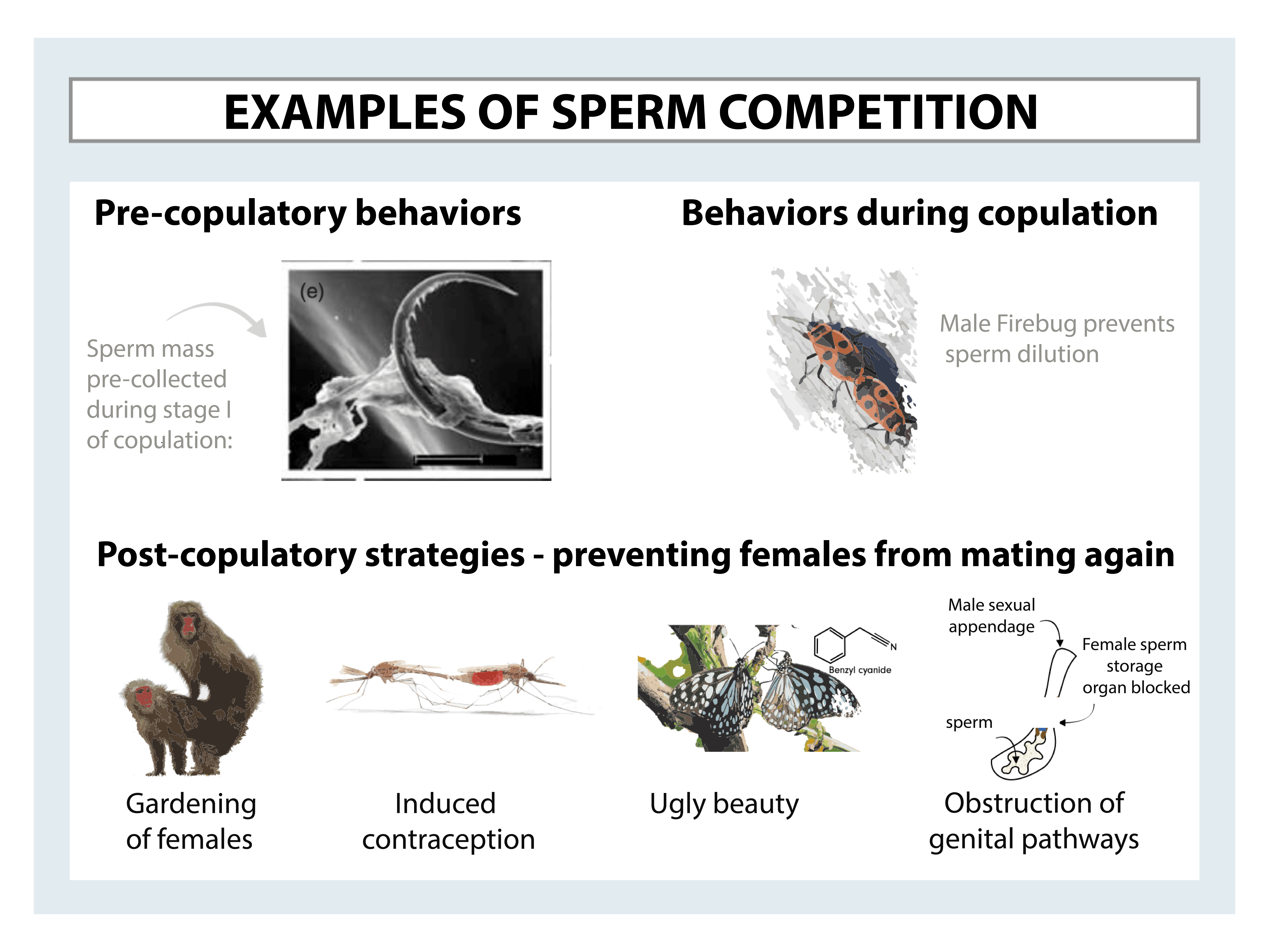
The animal world is full of cheats!
So far we’ve seen that secondary sexual characteristics (for example, the peacock’s tail) were honest indicators of the underlying quality of the males. The costs associated with producing and maintaining these extravagant features informed the females about the overall health of the males that wore them. The more physically fit a male is, the more access he has to quality energy resources. And the more he is able to waste them strutting around the forest with a very long tail. Some males have seen this as an opportunity to optimise their energy allocation by reducing certain costs associated with secondary sexual traits without damaging their overall reproductive success. This is where cheating comes in!
Examples of cheaters
Some male spiders fill their nuptial gifts with silk instead of prey to fool females and reproduce for longer [14].
As they are unable to compete with the larger males, some will trick the females into fertilisation all the same. In some amphibians, the smaller males will closely follow the larger males and grab the females attracted to them.
The males of other fish species will take advantage of fertilisation by throwing sperm into the water to mix theirs with that of other fish. In some beetles, the males will fertilise the females in secret while a larger male stands guard.
Finally, many females choose males who will give up all their time to help with feeding or defend the territory. The males thus find themselves torn between staying with the female and impregnating as many females as possible. As a result, it is not uncommon to observe males sneaking off to impregnate other females. A study of birds, the Prothonotary Warbler, showed that nearly 27% of offspring were identified as the result of extra-pair mating [15]!
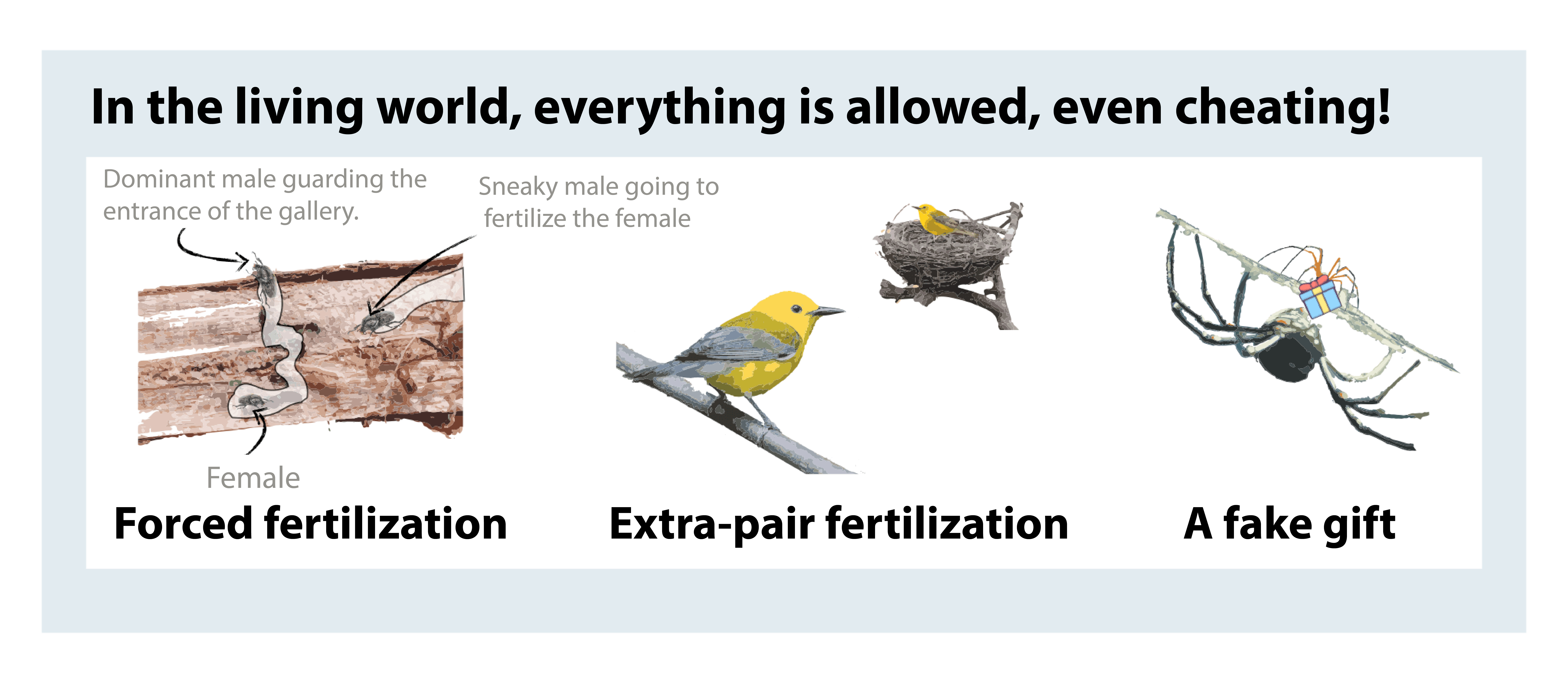
A final word
Historically, the field of sexual selection is still very young. Indeed, research in this field only began in the 1960s [22]. So it’s not surprising that the concept of sexual selection remains little known, even though the general public is already familiar with natural selection.
Science is not neutral. Scientists are caught up in an axiological matrix from which they cannot free themselves, and from which it is undesirable for them to free themselves, as this would deprive science of its human dimension. It is wrong to think that when a scientist puts down his hat and coat and puts on his white coat, he removes the interpretative filter between us and reality.
So we need to remain cautious about the observations we make about the world around us. Although we can have very serious studies on the subject, the fact remains that our perception of things is subjective, especially in a world as complex as ours. The idea of a common value is difficult to maintain. So now, more than ever, we need to share the knowledge and viewpoints of a diversity of researchers on a research topic, because that’s how we can minimise our personal interpretations.
Back to the article
In this article we have just seen a few examples that I have chosen, but in reality there are as many differences as there are species. I haven’t even mentioned species that don’t reproduce sexually or those in which the sex changes over the course of an individual’s life (but that’s only part of the story)! Personally, I’m still fascinated by all the singularities that surround us, especially as sexuality in general shapes and occupies a key place in evolutionary processes: the passing on of genes!
Illustrations: Vincent Lhuillier & Salomé Bourg Reviewing: The Project Pangolin team
References
1- Darwin, C., 1875. The Descent of Man, and Selection in relation to Sex. Nature, 11(277)
2- T, A., 2021. R78 : Pourquoi des sexes différents, et pourquoi deux le plus souvent? par T. Giraud et S. Billiard - sfecologie.org.
3- Albo, M. and Peretti, A., 2015. Worthless and Nutritive Nuptial Gifts: Mating Duration, Sperm Stored and Potential Female Decisions in Spiders. PLOS ONE, 10(6)
4- Gwynne, D., 2008. Sexual Conflict over Nuptial Gifts in Insects. Annual Review of Entomology, 53(1)
5- Andrade, M., 1998. Female hunger can explain variation in cannibalistic behavior despite male sacrifice in redback spiders. Behavioral Ecology, 9(1)
6- Toft, S. and Albo, M., 2016. The shield effect: nuptial gifts protect males against pre-copulatory sexual cannibalism. Biology Letters, 12(5)
7- Cecie Starr and Ralph Taggart, Biology – the Unity and Diversity of Life, 6th Ed., Wadsworth Publishing Company, 1992
8- Edward T. Hall, The Hidden Dimension, New York, Anchor Books, 1966
9- Córdoba-Aguilar, A., Uhía, E. and Rivera, A., 2003. Sperm competition in Odonata (Insecta): the evolution of female sperm storage and rivals’ sperm displacement. Journal of Zoology, 261(4)
10- Gangrade, G., 1964. Accessory glands of female phasmid, Necroscia sparaxes Westwood. Annals and Magazine of Natural History, 7(84)
11- Helinski, M., et al., 2012. Duration and dose-dependency of female sexual receptivity responses to seminal fluid proteins in Aedes albopictus and Ae. aegypti mosquitoes. Journal of Insect Physiology, 58(10)
12- Parker, G., 1970. Sperm competition and its evolutionary consequences in the insects. Biological Reviews, 45(4)
13- van Noordwijk, A. and de Jong, G., 1986. Acquisition and Allocation of Resources: Their Influence on Variation in Life History Tactics. The American Naturalist, 128(1)
14 - Ghislandi, P., et al., 2017. Silk wrapping of nuptial gifts aids cheating behaviour in male spiders. Behavioral Ecology, 28(3)
15 – Morton Catherine Heidrich Virginia., 2013. PhD thesis. Who’s Your Daddy? A Study of Extra-Pair Copulation and Mating Behaviors of Protonotaria citrea Behaviors of Protonotaria citrea.
16 - Sinervo, B. and Lively, C., 1996. The rock–paper–scissors game and the evolution of alternative male strategies. Nature, 380(6571)
17- Puts, D., 2021. Human sexual selection. 20015. Current Opinion in Psychology.
18- Scott, I., et al., 2014. Human preferences for sexually dimorphic faces may be evolutionarily novel. PNAS, 111(40)
19- Wheatley, J.,et al., 2014. Women’s faces and voices are cues to reproductive potential in industrial and forager societies. Evolution and Human Behavior, 35(4)
20- Collins, S. and Missing, C., 2003. Vocal and visual attractiveness are related in women. Animal Behaviour, 65(5)
21- Singh, D., et al., 2010. Cross-cultural consensus for waist–hip ratio and women’s attractiveness. Evolution and Human Behavior, 31(3)
22- Giraldeau, L., Cézilly, F. and Danchin, E., 2005. Écologie comportementale. Paris: Dunod.
Enjoy Reading This Article?
Here are some more articles you might like to read next: